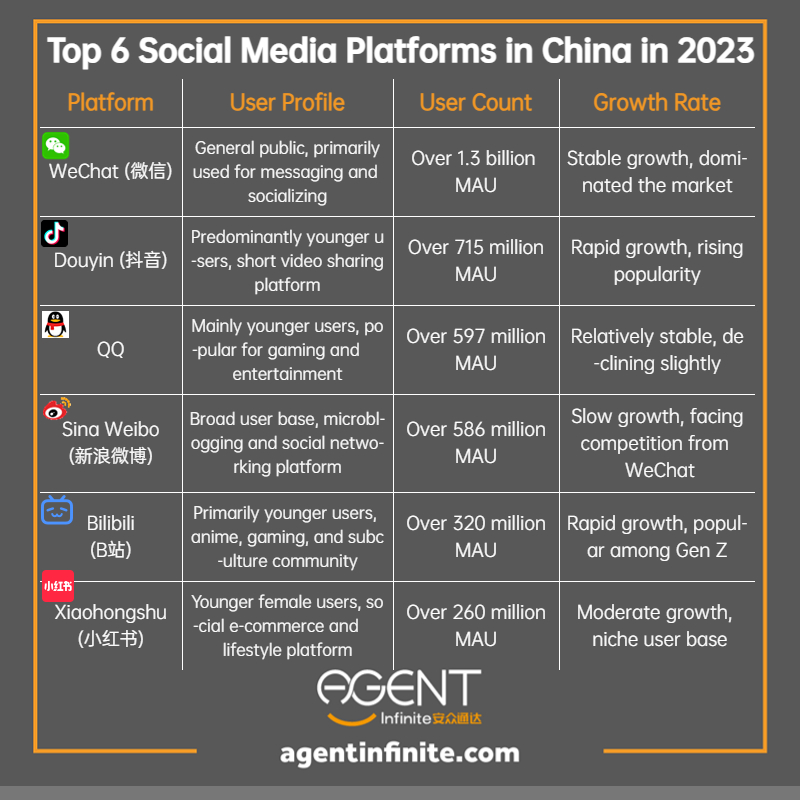
Navigating China’s digital landscape can be overwhelming for businesses hoping to penetrate this vast market. China’s digital ecosystem is unique, dynamic, and home to a variety of social media platforms that cater to diverse demographics and interests. It’s vital to comprehend these platforms, their user base, and their growth trends to make an impact in China.
In this blog, we explore the six most popular social media platforms in China as of 2023. Our overview analyzes each platform’s user count, user profiles, and growth rates. This information serves as a guide for businesses to identify the platforms with the most active target audiences, understand potential market size, and observe growth trends.

1. WeChat (微信)
WeChat is a widely popular app in China that has revolutionized the way people communicate and live. With over 1.3 billion monthly active users, it has transformed from a simple messaging app to a comprehensive ecosystem that infiltrates every aspect of life.
WeChat offers features like QR code friend adding, voice and video calls, group chats, and emoticon fights that have revolutionized social interactions. Additionally, WeChat Mini Programs and WeChat Stores have attracted numerous businesses to set up shops, making it an ideal platform for businesses to reach a broad audience and tap into various market segments.
WeChat Pay has become a new marketing strategy for brands, and businesses can leverage multiple touchpoints to engage with their target audiences. WeChat’s integration with other Tencent ecosystem products and various vertical platforms has further expanded its reach, providing businesses with a vast market to target.
With modes catering to teenagers, the elderly, and visually impaired individuals, WeChat’s audience covers the entire population, making it an ideal platform for businesses aiming to penetrate the Chinese market. In conclusion, WeChat’s multifunctionality, massive user base, and diverse features offer businesses a variety of tools and channels to effectively reach their target audience.

2. Douyin (抖音)
Douyin, also known as TikTok outside of China, is a popular platform for sharing short videos, particularly among the younger demographic. Initially established in 2016 as a music-centered social media platform, Douyin has since become a hub for creative expression, spawning countless articles, dances, cities, and influencers. Its evolution into a robust e-commerce platform has redefined both social media and online shopping.
Douyin has experienced explosive growth and is now a major player in the industry, with over 715 million monthly active users as of 2023. The year 2020 was dubbed the “Year of Live Streaming,” as live streaming became a significant driver of Douyin’s e-commerce success. The shift from photos to videos to live streaming has resulted in a rapid transformation of content, leading to changes in user shopping behavior.
Today, B2C brands are discussing Douyin more than ever. The platform has opened up new possibilities for social e-commerce, thanks to the entry of high-profile brands like LV and Gucci, as well as innovative live streaming sales models like Oriental Selection’s “Poetry and the Far-off.” Live streaming has allowed brands to become more three-dimensional, with live broadcast decor and rhetoric that align with each brand’s unique voice. Through intimate interaction

3. QQ
QQ is a well-known platform that is popular for gaming and entertainment, especially among younger users. It has a user base of over 597 million MAU in 2023, which has been relatively stable, although it has declined slightly. Despite facing competition from other platforms, QQ is still a preferred choice due to its wide range of entertainment features.
Businesses targeting younger users who are interested in gaming and entertainment can benefit from QQ’s appeal. QQ Music, QQ Game, and QQ Show are just a few of the integrated services that businesses can use to reach their target audiences.
QQ’s social networking features, such as Qzone and QQ Groups, offer businesses opportunities to build communities and engage with their target audiences. By sharing updates, promoting products or services, and communicating with users, businesses can increase their brand visibility and strengthen their customer relationships.
QQ offers a range of advertising solutions, including banner ads, news feed ads, and video ads, which enable businesses to reach their target audience effectively. Its data analytics tools provide valuable insights into ad performance, user behavior, and market trends to help businesses optimize their marketing strategies.
Despite a slight decline in its user base, QQ’s wide range of features and strong appeal to younger users make it an attractive platform for businesses looking to enter the Chinese market, especially those in the gaming and entertainment sectors. Its robust ecosystem and diverse user base provide a fertile ground for businesses to grow and thrive.

4. Sina Weibo (新浪微博)
Sina Weibo was founded in 2009 and has had its fair share of ups and downs over the years. Despite facing stiff competition from other social media platforms, Weibo has managed to establish itself as a leader in current affairs, hot topics, celebrity entertainment, and film and television, thanks to its commercialization model and Sina portal website genes.
Weibo’s content is highly timely and topical, making it easy for strangers to connect over a single topic. The platform’s short-form content and unrestricted publishing frequency make it easy for users to produce, read, and view content. Interaction on the platform is also high, with users engaging with both creators and other users.
Though Weibo’s growth has been slow, its user base of over 586 million in 2023 provides a vast market for businesses to target. The platform’s appeal to users interested in current affairs, entertainment, and social issues makes it an ideal platform for businesses to tap into these demographics.
Weibo’s unique position in China’s social media landscape and its diverse interactive features make it an attractive platform for businesses looking to penetrate the Chinese market, especially for those interested in topic and emotional marketing.

5. Bilibili (B站)
Bilibili, a platform originally focused on ACG (Animation, Comics, and Games) long videos, has gained popularity among Gen Z users due to its unique circle culture, barrage (danmu) culture, and strong learning atmosphere. It currently has over 320 million monthly active users and is known for its impressive user stickiness. Brands targeting the young demographic can benefit from marketing on Bilibili by integrating into the platform’s culture and resonating with the audience.
To meet users’ fragmented content needs and increase ad load and monetization rate, Bilibili launched Story Mode, a vertical video display format suitable for watching short videos. This has attracted more creators and broadened the age range of users, including middle-aged users. The diverse advertising forms have also increased Bilibili’s revenue.
Overall, Bilibili’s unique position, ability to connect users through shared interests, and interactive features make it an attractive platform for businesses looking to penetrate the Chinese market, particularly those interested in video marketing and targeting Gen Z users.

6. Xiaohongshu (小红书)
Xiaohongshu, also known as “Little Red Book,” is a platform that caters to lifestyle enthusiasts and provides a space for “planting grass.” Initially, it was a community for overseas shopping guides, but it has since evolved to become a closed-loop e-commerce platform. With over 260 million monthly active users, Xiaohongshu has established itself as a popular social media platform in China, attracting users with high purchasing power and a keen interest in sharing their lifestyle experiences.
The platform’s user-generated content is diverse and offers various possibilities for users to explore different lifestyles. This diversity has created a natural sense of trust and high stickiness among the users. “How to buy” is a high-frequency question asked by Xiaohongshu users, and the platform’s “planting grass” path, which involves consideration, action, and sharing, has become a habit for many users.
Graphic notes are a popular form of content on Xiaohongshu, with a higher information density, better searchability, and higher reading efficiency than videos. This makes graphic notes a more preferred format for users and a better option for brands looking to market their products.
Xiaohongshu has attracted over 140,000 brand merchants and has introduced a new indicator
Conclusion: Navigating China’s Social Media Landscape for Effective Marketing
To effectively market your business in China, it is crucial to have a good understanding of the social media landscape. This blog has provided an overview of the top six social media platforms in China in 2023. By identifying the platforms with the most active target audiences, businesses can understand potential market size and growth trends. Each platform has its unique features, user demographics, and growth trajectories, which offer different opportunities for businesses to connect with their target audiences and achieve their marketing goals.
This blog is the first in a series aimed at helping businesses navigate China’s digital landscape for effective marketing. Subsequent blogs will provide detailed marketing tips and strategies for each platform. By gaining a comprehensive understanding of these platforms, businesses can develop tailored marketing strategies that resonate with their target audiences and drive business growth.
Navigating the complexities of China’s digital landscape can be challenging. If you need personalized advice or assistance, Agent Infinite is here to help. Our team of experts is ready to help you leverage these platforms to their fullest potential and achieve your marketing objectives in the Chinese market.


Comments
comments powered by Disqus